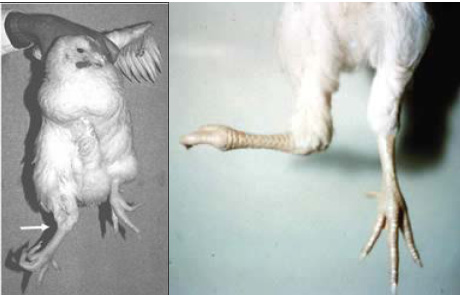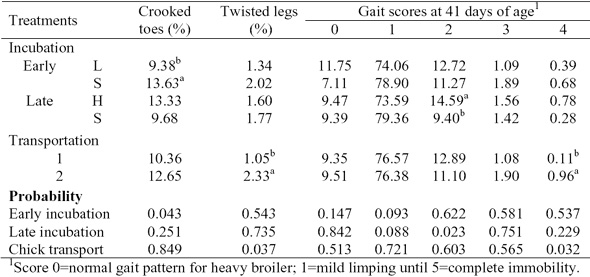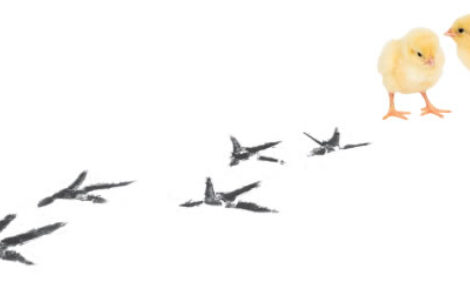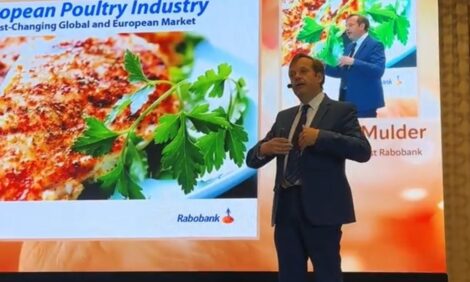



Leg Health in Large Broilers
Leg health is one of the most prevalent causes of culling and late mortality during grow-out of heavy broilers according to Edgar O. Oviedo-Rondón, DVM, PhD., Dip. ACPV Department of Poultry Science North Carolina State University.Introduction
Leg health is one of the most prevalent causes of culling and late mortality during grow-out of heavy broilers. Leg problems are also sporadically observed during the first weeks of life causing increments in early culling as well. Leg issues have a major impact on welfare audits. The incidence of clinical lameness or leg disorders is typically less than 2 or 3%. However, many more broilers are subclinically affected presenting changes in gait patterns, reduced walking ability with detrimental effects for feed conversion and growth.
Even though, these leg problems seem to have a low incidence, they are very prevalent and all flocks have at least one percent of birds with some type of leg problems. The live production losses are just a small part of the economical impact of leg problems. Current statistics suggest that the downgrades and carcass trims associated with broilers that have leg problems increase costs per kilo of live weight. Lame birds spent much more time lying in the litter and bring more contamination to the processing plant increasing problems of food safety. Lame broilers have more condemnations like breast blisters, scratches and inflammatory processes (IP). Vaillancourt and Martinez (2002) reported a correlation between IP and angular leg deformities. Some of the skeletal deformities affect the operation of automatic evisceration and deboning equipment, thus impacting processing line speeds, the requirement of manual trimming and meat losses. Additionally, bone fragility affects the color quality of the deboned products and bone fragments represent a physical hazard. These facts indicate that improving leg health in broilers may bring several economical benefits to a broiler operation beyond addressing the welfare issues.
The incidence of each specific leg problem varies among farms and companies, and it is important to identify the specific problem(s) to program adequate strategies to reduce the incidence of these costly issues. The objectives of this presentation are to present some of the most common leg problems, the score methods used to measure their incidence, and to discuss some of the causes of leg disorders and the strategies to reduce their incidence at farm level.
Common leg problems observed in heavy broilers
Bone disorders are not the only factor involved in leg health. Tendons, ligaments, articulations and nerves can also be affected and it is more difficult to find solutions to problems caused by these components of the skeletal system. Valgus (VVD), crooked toes, tibial dyschondroplasia (TD), vertebral deformities, twisted legs, osteoporosis of the proximal femur, and femoral head necrosis are the most common skeletal pathologies causing leg problems. Additionally, leg problems and changes in locomotion are also increased when footpad dermatitis and hock burns are observed. Currently, it is rare to observe slipped tendons, or ruptured gastrocnemius associated with either viral arthritis or Staphylococcus as etiologies of leg problems in commercial flocks. In contrast, it is common to hear that vaccinations may help with leg problems without any clear reason.

Twisted legs

Some of these leg problems may be independent, while others are correlated. For example, VVD and vertebral deformities may be linked. Droual et al. (1991) reported an association between scoliosis and angular change in the tibiotarsi. Though a cause and effect was not proven, Droual’s work suggests that an angular leg deformity could predispose to a vertebral deformity.
Tibial Dyschondroplasia (TD) in proximal epiphyses of tibias
This is one of most common bone developmental problems. TD causes articulation pain and changes in broiler gait patterns. TD can also cause deformations of tibias with more noticeable changes in angulations of legs. TD should be differentiated from rickets. It is normally reported in broilers older than 35 days of age. TD has many different pathophysiologic mechanisms; however the late rapid growth rate may be one of the main causes under commercial conditions.

These leg or bone problems can be evaluated by either observation of broiler body posture or by necropsy. The evaluation of walking ability is evaluated by gait scores. At this moment there are two main systems of gait scoring: the Kestin system (Kestin et al., 1992) and the US System under approbation by the American Association of Avian Pathologist (AAAP).
Management causes of leg problems in broiler flocks
Leg problems and developmental disorders of long bones can be affected by genetics, breeder nutrition, incubation, infectious diseases, and environmental stressors caused through the life of the broiler (Bradshaw et al., 2002; Oviedo-Rondón et al., 2006 a, b).
Breeder nutrition, incubation and chick transportation
Our results of more than 12 experiments at NC State University indicated that maternal nutrition and incubation conditions may affect leg health. Adequate warm pre-incubation with good air flow while avoiding low early cool incubation conditions are critical for proper bone development, reduced relative asymmetry between both legs, and decreased incidence of crooked toes and twisted legs. Hot temperatures and hypoxia during late incubation (last four days) reduced bone development and increased relative asymmetry of long bones. We also observed the beneficial effects of improved incubation on the incidence of leg problems under commercial conditions in large trial in collaboration with an integrator company in North Carolina.
The appropriate transportation conditions from hatchery to farm are also important to avoid leg problems. We evaluated effects of embryonic incubation temperatures and posthatch transportation stress on long bone development at hatch and leg health of broilers at 41 days of age. A total of 5,200 Cobb 500 fertile eggs were incubated so as to achieve an egg shell temperature of 36.7°Cm 98.1 oF (L), or a standard egg shell temperature of 37.5°C, 99.5 oF (S) during the first week of incubation. During the third week of incubation the eggs were incubated so as to achieve the S egg shell temperature or an egg shell temperature of 39°C, 102.2 oF (H). All eggs were incubated at S during days 8 to17, with combinations of the other temperatures occurring on day 1 to 7 and day 18 to 21 days to generate four incubation treatments: SS, SH, LS, and LH. At 41 days of age (Table 1), males had more (P<0.001) leg problems than females. Late hot temperatures and hot transportation conditions (T2) increased (P<0.01) incidence of crooked toes and percentage of chickens with gait score 2 and 4, respectively. Bad transportation conditions (T2) caused higher incidence of twisted legs (P<0.05). We concluded that low early and hot late incubation temperatures, and stress during transportation may affect early development of long bones and increase the incidence of leg problems.

Early growth and brooding management
Skeletal defects such as varus/valgus deformities and kinky back (spondylolisthesis) are exacerbated when a producer cannot either control early growth rates or create conditions that derivate in very uneven flock early in life. These conditions are uneven brooding temperatures in the house, excessive cold or hot litter temperatures, cold draught, not enough feed space or water availability, or not enough light. Any of these uncomfortable conditions for broilers during brooding reduce their early feed intake and physical activity and both affect leg bones, muscles and tendon development.
It is important that broilers reach at 7 days of age body weights that are four times their initial body weight. This means that the average body weight should be between 160 – 180 grams (average 0.37 lbs) at the end of the first week. Flock uniformity can be measured by the coefficient of variance (CV %) of the population obtained with data of individual body weights. This value should not be higher than 10% during the first week of life. However, it is not unusual to observe flocks with average body weights lower than 145 grams, or several individuals in the flock with 100 grams or less and 200 grams or more. Under these circumstances, the CV is 14% or higher. In this type of uneven flocks with individuals that have rapid early growth is common to observe leg problems later on in life.
Lighting programs
Lighting programs are the most common management methodology to reduce early growth. The lighting programs are very variable among companies and even among growers. Most of lighting programs with some hours of darkness (4 to 9 hours) and dimmed lights (less that 0.5 foot candle) during the daily light period, after the first week of age can effectively slow early growth rate, while improving feed conversion. In some cases, lighting programs also minimize cardiovascular and metabolic diseases such ascites, and the incidence of some skeletal anomalies such as tibial dyschondroplasia. However, lighting programs may be predisposing flocks to enteric disease and malapsorption by encouraging litter foraging (Schwean-Lardner et al., 2006a, b). Enteric diseases, “flushing syndrome” or feed passage syndrome are common between 12 and 28 days of age in commercial broiler flocks. These gut health problems are concomitant with changes in lighting intensity, long darkness periods, and changes in feed types from starter to grower. Malabsorption during early rapid growth induces rickets or osteoporosis of proximal femur, and VVD. In this case, it is not the diet per se, but the amount and balance of nutrients truly absorbed at the intestinal level the one that increases bone disorders.
Lighting programs are normally designed to reduce growth rates between the second week of life and two weeks prior to processing. These programs diminish bird activity during most of the day and reduce its maximum voluntary feed consumption, while improving feed conversion. During the last two weeks prior to processing, the light is increased to stimulate feed intake and consequently growth. However, this rapid growth compound with the previous lack of exercise or physical activity causes leg issues such as TD and VVD, as well as compensatory increase in longitudinal growth of leg bones that may not be symmetric in both legs. This asymmetry in the legs may affect gait patterns and impact the performance of some of the heaviest broilers in the flock.
Management strategies to reduce leg problem incidence
Good management practices to guarantee the uniformity of optimum temperatures according to the age of the embryo, and good ventilation within the incubators and hatchers may help to reduce leg problems in the field. Optimum brooding temperatures, good air quality, enough feeder and drinker space and light with intensities higher than 2 foot candles during the first week of life will improve early growth and bone development. All the practices used to avoid enteritis like proper management of feed, maintaining clean feed bins, feed lines, pans and water lines are necessary to avoid bone developmental problems. If the current lighting program is not reducing the incidence of leg problems, and litter foraging is observed, the program should be revised and allow more time for exercise and promote use of feed pans.
Water additives
Supplementation of vitamins to broiler drinking water is common in the industry. However, the experimental results on the benefits of supplementing vitamins in the water in addition to the ones supplemented in the feed to prevent leg disorders and cartilage problems in broilers are highly variable. Results of several experiments were reviewed by Oviedo-Rondón et al. (2006b). This high variability in the response to vitamin supplementation could be due to the genetic variability of the broiler genetic strains used and the degree of stress of those chickens during the experiments. Vitamin supplementation in the drinking water may help during the recovery period after situations of enteric disease and malabsorption.
Vitamin D and C are two of the main vitamins that can be added in drinking water with clear impact on leg health and bone development. These two vitamins even work together in bone metabolism. The level of vitamin D3 used by the commercial industry in the United States is commonly 9 times higher than the NRC (1994) recommendations for broilers. Thus, it is very rare to observe any possible deficiency of vitamin D under commercial conditions unless there are mixing problems, mistakes in adding the vitamin to the feed or enteric disease.
Vitamin C is also added in the water of broilers for stress situations. The beneficial effects of vitamin C supplementation have been clearly linked to modulation of glucocorticords such as corticosterone under heat stress conditions and many other stressors. Some benefit on reducing TD was observed when vitamin C was supplemented to diets with very low Vitamin D, only 2 μg/kg of 1,25-(OH)2D3. Using even higher levels of Vitamin C (250, 500 or 1,000 mg/Kg of diet) in diets devoid or with only small amounts of Vitamin D, (10 μg/kg of 1,25-(OH)2D3) did not improve TD even under low-Calcium and highphosphorus diets.
Water soluble vitamin deficiencies play important roles in skeletal disorders. Although a common commercial corn-soybean meal diet may contain enough of these vitamins, it has been proven that they are not sufficiently bioavailable for bone development of fast growing chickens. Sufficient vitamin fortification of diets with synthetic sources is necessary and commonly done in the industry. However, the vitamin premixes included in diets are commonly not formulated to supply the minimum NRC (1994) recommended levels for thiamine, pyridoxine and biotin according to an industry survey done by BASF in 1998. Marginal pyridoxine (vitamin B6) deficiencies are involved in hyperhomocysteinemia and reduced activity of lysyl oxidase fundamental for elastin and collagen cross linking. Several research reports suggest that the high blood levels of homocysteine, and low levels of folate, vitamins B6 and B12 affect bone metabolism, increasing TD incidence, reducing bone structure, quality and increasing fracture risk in chickens and humans. Deficient biotin dietary levels are associated with pododermatitis in broilers.
In conclusion, supplementation of vitamins in drinking water of broilers may help under stressful conditions and enteric diseases, but extra vitamins are not an adequate treatment or prevention measurement of leg problems.
Vaccines?
Viral arthritis/tenosynovitis caused by reovirus and Staphylococcus spp. infections can cause leg problems. Staphylococcus infection can be prevented with proper house sanitation between flocks, minimizing human manipulation of birds, and keeping healthy birds. Reovirus infection caused viral arthritis or tenosynovitis (Rosenberger, 2003). Reovirus infections are additionally prevented with vaccines applied directly to broiler breeders. However, it has become more common to observe vaccination in commercial broiler with reovirus strains that cause tendon problems. The following signs are characteristic of viral arthritis: 1) Swelling and inflammation of digital flexor and metatarsal extensor tendon sheaths; 2) Foot pad swelling; 3) Ulceration of articular cartilages; 4) Haemorrhage in tissues around the articulation (green leg disease) and 5) Fibrosis in chronic cases. If you do not observe these signs in your flocks and do not have confirmation or reovirus infection, you may not need to use these vaccines. Live virus vaccines, like the ones used to prevent viral arthritis, always cause an immunological reaction that reduces broiler growth and affect feed conversion.
References
BASF Corporation. 1998. Vitamin supplementation rates for US commercial poultry swine and dairy cattle. KC 9305 2nd revised edition, Revised 7/98.
Bradshaw, R.H., Kirkden, R.D. and Broom, D.M. (2002) A review of the aetiology and pathology of leg weakness in broilers in relation to welfare. Avian Poultry Biology Reviews 13:45–103.
Droual, R., Bickford, A.A., and Farver, T.B. 1991. Scoliosis and tibiotarsal deformities in broiler chickens. Avian Diseases. 35:23-30.
Kestin S.C., Knowles T.G., Tinch A.E. and Gregory N.G., 1992. Prevalence of leg weakness in broiler chickens and its relationship with genotype. Veterinary Record 131: 190-194.
NRC. 1994. Nutrient Requirements of Poultry. 9th Rev. Ed. National Academy Press, Washington, DC.
Oviedo-Rondón, E.O., P.R. Ferket and G.B. Havestein. 2006a. Understanding long bone development in broilers and turkeys. Avian and Poultry Biology Reviews 17(3):77-88.
Oviedo-Rondón, E.O., P.R. Ferket and G.B. Havestein. 2006b. Nutritional factors that affect leg problems in broilers and turkeys. Avian and Poultry Biology Reviews 17(3):89-103.
Rosenberger, J.K. 2003. Viral Arthritis In: Diseases of poultry, 11th ed. Y. M. Saif, ed. Iowa State Press, Ames, IA. pp. 284-293.
Schwean-Lardner, K., Classen, H.L. and Fancher, B.I. 2006a. The effect of daylength on the behavior of broiler chickens. Proceedings of the 2006 Poultry Science Association Annual Meeting. Abstract 204. Edmonton, Alberta, Canada. http://www.poultryscience.org/psa06/abstracts/toc.htm
Schwean-Lardner, K., Classen, H.L. and Fancher, B.I. 2006b. The effect of daylength on the behavior of broiler chickens. Proceedings of the 2006 Poultry Science Association Annual Meeting. Abstract 205. Edmonton, Alberta, Canada. http://www.poultryscience.org/psa06/abstracts/toc.htm
Vaillancourt, J-P., and Martinez, A. 2002. Inflammatory process (IP) causes and control strategies. Zootechnica June: 48-53.
May 2008









